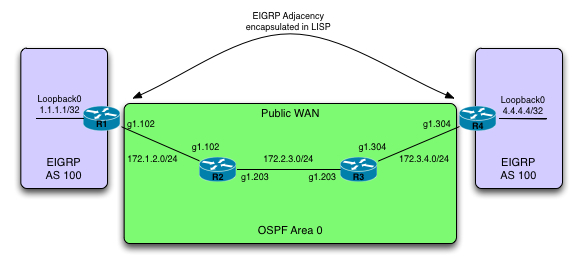EIGRP OTP example
In this post id like to provide an example of a fairly new development to EIGRP which is called EIGRP Over The Top (OTP).
In all its simplicity it establish an EIGRP multihop adjacency using LISP as the encapsulation method for transport through the WAN network.
One of the applications of this would be to avoid relying on the SP in an MPLS L3 VPN. You could simply use the L3 VPN for transport between the interfaces directly connected to the Service Provider and run your own adjacency directly between your CPE routers (without the use of a GRE tunnel, which would be another method to do it)
The topology used for this example consists of 4 routers. All 4 of the routers are using OSPF to provide connectivity (you could take this example and do a L3 VPN using MPLS as an exercise). Im simply taking the lazy path and doing it this way 🙂
R1 and R4 are running EIGRP in a named process “test”. This process is in Autonomous system 100 and the Loopback 0 interfaces are advertised into the V4 address-family.
Lets verify that we have connectivity between R1’s g1.102 interface and R4’s g1.304 interface:
R1#ping 172.3.4.4 so g1.102 Type escape sequence to abort. Sending 5, 100-byte ICMP Echos to 172.3.4.4, timeout is 2 seconds: Packet sent with a source address of 172.1.2.1 !!!!! Success rate is 100 percent (5/5), round-trip min/avg/max = 1/5/19 ms
All looks good.
Now lets take a look at the configuration that ties the R1 and R4 together with an EIGRP adjacency:
on R1:
R1#sh run | sec router eigrp router eigrp test ! address-family ipv4 unicast autonomous-system 100 ! topology base exit-af-topology neighbor 172.3.4.4 GigabitEthernet1.102 remote 10 lisp-encap 1 network 1.0.0.0 network 172.1.0.0 exit-address-family
Whats important here is line 8 and 10.
In line 8, we specify that we have a remote neighbor (172.3.4.4), which can be reached through g1.102. The maximum number of hops to reach this neighbor is 10 and we should use lisp encapsulation with an ID of 1.
Also in line 10, its important to add the outgoing interface into the EIGRP process. I’ve found that without doing this, the adjacency wont come up. Its not enough to specify the interface in the neighbor command.
Lets verify which interfaces we are running EIGRP on at R1:
R1#sh ip eigrp interfaces
EIGRP-IPv4 VR(test) Address-Family Interfaces for AS(100)
Xmit Queue PeerQ Mean Pacing Time Multicast Pending
Interface Peers Un/Reliable Un/Reliable SRTT Un/Reliable Flow Timer Routes
Lo0 0 0/0 0/0 0 0/0 0 0
Gi1.102 1 0/0 0/0 1 0/0 50 0
On the reverse path, on R4:
R4#sh run | sec router eigrp router eigrp test ! address-family ipv4 unicast autonomous-system 100 ! topology base exit-af-topology neighbor 172.1.2.1 GigabitEthernet1.304 remote 10 lisp-encap 1 network 4.0.0.0 network 172.3.0.0 exit-address-family
Same deal, just in the opposite direction.
Thats about it, lets take a look if we have the desired adjacency up and running:
R1#sh ip ei nei
EIGRP-IPv4 VR(test) Address-Family Neighbors for AS(100)
H Address Interface Hold Uptime SRTT RTO Q Seq
(sec) (ms) Cnt Num
0 172.3.4.4 Gi1.102 12 01:14:16 1 100 0 3
Excellent! and the routing tables:
R1#sh ip route eigrp | beg Gateway
Gateway of last resort is not set
4.0.0.0/32 is subnetted, 1 subnets
D 4.4.4.4 [90/93994331] via 172.3.4.4, 01:14:50, LISP1
Pay attention to the fact that LISP1 is used as the outgoing interface.
And finally the data plane verification:
R1#ping 4.4.4.4 so loo0 Type escape sequence to abort. Sending 5, 100-byte ICMP Echos to 4.4.4.4, timeout is 2 seconds: Packet sent with a source address of 1.1.1.1 !!!!! Success rate is 100 percent (5/5), round-trip min/avg/max = 1/10/25 ms
Great! – and thats about all there is to a simple EIGRP OTP scenario. (Look into EIGRP “Route Reflectors” if you want more information on hub-and-spoke topologies).
Take care!
